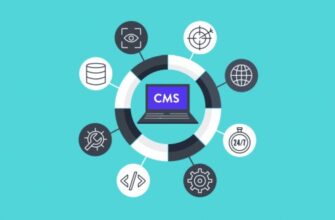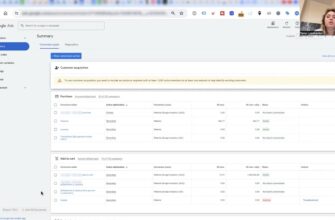- What is OpenCart?
- Advantages of the OpenCart platform
- Main disadvantages of OpenCart CMS
- Who is the OpenCart engine suitable for?
- Overview of the functionality of the OpenCart platform
- Design and templates
- Administrator panel
- Extensions and modules
- Accepting online payments
- Integration with external services
- Analytics and statistics
- Export and import of data
- Opportunities for promoting the site on CMS Opencart
- SEO optimization
- Blog connection
- The cost of using the Opencart engine
OpenCart is one of the oldest systems for creating online stores. First introduced in 1999, it initially developed rather slowly. However, in 2009, the English developer Daniel Kerr took up the task of modernizing it – he rewrote the code from Perl to PHP and added additional functions, which marked the beginning of a new stage in history.
Today the OpenCart platform is a professional solution for creating online stores at minimal cost. It is characterized by high speed and low server requirements. Thanks to this, even beginners can easily cope with creating a simple and effective online store. In this review of OpenCart CMS we will look at its main tools and advantages.
What is OpenCart?
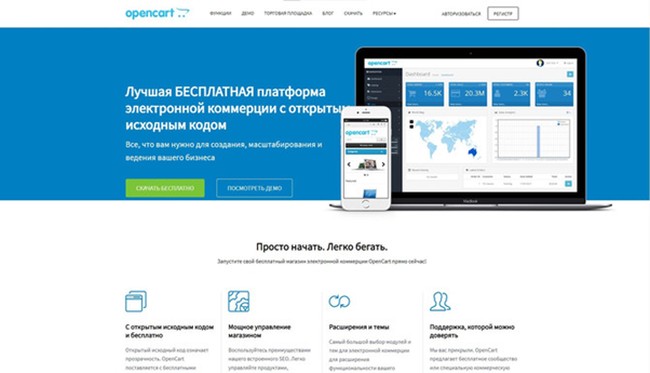
How many calls and sales will I get by ordering contextual advertising from you?
I need to calculate the conversion of my website Describe
the task
in the application
Calculate potential ad revenue Google
contextual advertising calculator
OpenCart is an easy-to-learn and fairly well-known system for creating online stores. Unlike Drupal or DLE, it is intended specifically for e-commerce projects, and not one-pagers or service sites. Over the years of its existence, OpenCart has gained popularity around the world. For example, in the USA it is among the top 4 most used CMS for online commerce.
Using the engine, you can create a trading platform of any complexity and theme. Already in the basic package there is all the necessary set for accepting online payments and processing orders, and if desired, it can be expanded with ready-made plugins. The marketplace offers many free and paid modules.
It’s quite easy to understand the engine, it has a huge community around the world, and you can find a lot of training videos and useful information for beginners on the Internet. In addition, thanks to the open source code, experienced developers can modify it and adapt it to specific tasks. If you don’t have enough experience to make changes yourself, you can contact a specialized web company.
Advantages of the OpenCart platform
The following points should be included in an overview of the advantages of the OpenCart platform:
- Open source. This provides a huge number of opportunities for specific business tasks. Thanks to this, a community of experienced developers is constantly expanding its potential, releasing updates and eliminating vulnerabilities.
- Ready functionality. The basic version provides a full set of tools: tools for maintaining a customer base, receiving and tracking orders, setting up promotions and promotional codes, organizing mailings, etc.
- Lots of additional features. In addition to the ready-made set, there is a huge selection of extensions inside. Thanks to this, it is possible to adapt the platform to the needs of a specific business, be it filling several hundred or tens of thousands of positions.
- Multilingual support. OpenCart has been translated into more than 40 languages, which is important when entering international markets. You can also launch several online stores at once with different products, prices and customers within one admin panel. This is great for companies that operate in several niches at the same time.
- Integration with services. Using the engine, you can easily integrate an online store with CRM, payment and analytics services, etc. This expands the number of functions and increases the efficiency of business processes.
- Mobile commerce. Stores perfectly adapt to screens with any resolution, which is important in modern realities, when more and more purchases are made through smartphones. You can also build a ready-made solution based on OpenCart using the API, which makes it possible to create applications and connect a backend to them.
- Powerful analytics. Web analytics functions are already integrated inside, thanks to which you can track the effectiveness of advertising campaigns, analyze visitor behavior and collect valuable statistics. If necessary, analytics can be expanded by connecting external applications.
- Convenient customer management. Inside there is developed functionality for working with the client base – a personal account, as well as a flexible system of discounts, bonuses and mailings. Thanks to this, you can effectively interact with the target audience and increase loyalty.
- Functional control panel. The admin panel has a clear interface and a wide range of administration functions. All key information is displayed on the main screen – sales statistics, information about orders, inventory balances, etc. There are also tools for administering the product catalog and content, which help you quickly control processes and manage your business.
- Built-in email marketing tools. This is a great way to promote promotions, new arrivals and increase audience loyalty. Mailings can be sent either en masse to all subscribers or targeted to specific groups.
- Setting access rights. Inside, a role model with standard and custom groups is implemented, which distributes access rights to sections of the administrative panel between employees depending on the functions performed. For example, this way you can set up limited access to important information.
- Availability. The basic version is distributed under a free license. This is enough to create a small online resource with minimal costs, which is an ideal option for startups and newcomers to e-commerce.
- Compatible with almost any hosting. OpenCart works on the vast majority of servers. Some hosting providers provide the ability to install it in one click. You just need to create a database and enter an administrator account, which saves a lot of time.
Main disadvantages of OpenCart CMS
Like any content management system, OpenCart has certain disadvantages that you should be aware of:
- Irregularity of updates. The release cycle is quite chaotic and unsystematic. In terms of the pace of development, it lags far behind its main competitors in the e-commerce market, which, in turn, creates difficulties in maintaining the current version.
- Numerous paid plugins. Many useful add-ons that add important functionality have to be purchased separately, which significantly increases business costs.
- Difficulty in mastering the admin panel. Its interface is quite difficult to understand. It is more aimed at advanced users and technical specialists. For beginners, the admin panel may seem insufficiently intuitive.
- The need to edit the source code. To implement non-standard tasks on the site or change the design, sometimes there is a need to make changes to the code. This can be a difficult task if a technician is not available.
- Weak SEO optimization. The basic version has a rather modest set of SEO tools. For example, without special plugins it will not be possible to overcome duplicate pages, create a multilingual resource optimized for search engines, and much more.
- Lack of built-in import and export. Out of the box, you will not be able to download and edit a table with products and categories onto your computer, which creates difficulties with processing large catalogs and transferring data. The only way out is to use third-party applications.
- Possible compatibility conflicts. Due to installed add-ons, compatibility problems often arise between modules and the system core. Especially after updates, some extensions may stop working correctly or errors may appear.
- Weak support for free add-ons. Many useful modules are no longer supported by developers over time. Their use becomes risky due to emerging vulnerabilities, so you have to look for a replacement or buy analogues.
- Difficulty installing templates. The process of customizing themes is quite labor-intensive and requires technical skills, which becomes a problem when changing the visual solution.
Who is the OpenCart engine suitable for?
The main target audience is entrepreneurs who want to quickly and practically without investment create an online store. Based on the platform, you can quickly launch a full-fledged website for small and medium-sized businesses and get the first results within a week. After installation and design selection, the site is ready to receive visitors. All that remains is to add product items, descriptions and start selling.
For large projects, OpenCart is also suitable, but you will need to invest in powerful hosting and purchase add-ons for integration with 1C and other programs. The system has no restrictions on the number of product items, however, you will need to pay attention to optimizing loading speed.
Among other things, OpenCart CMS is an excellent solution for businesses with a low average bill. Thanks to the ability to connect promotions, discounts and sales, you can encourage the buyer to purchase more goods or choose a more expensive product.
Newcomers to e-commerce are also delighted with OpenCart. To launch a basic trading platform, you will need initial skills in adding modules, moderating goods, etc.
In addition, the availability of open source code makes the system attractive to studios and freelancers who offer their services in developing online stores for businesses.
Overview of the functionality of the OpenCart platform
The system provides everything necessary to create a full-fledged trading platform. Let’s look at the key features that help entrepreneurs effectively sell online.
Design and templates
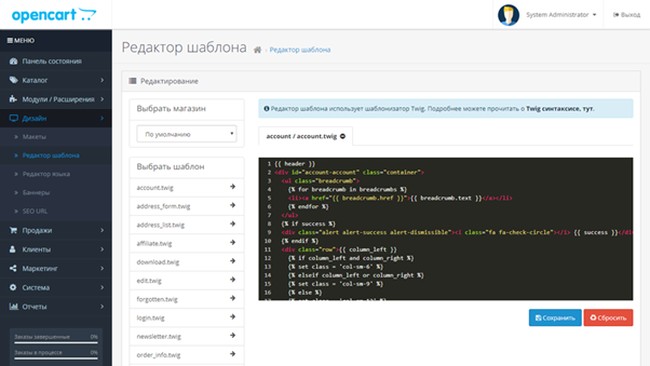
The internal marketplace offers a wide selection of ready-made themes. Premium templates are also available, ranging from $20 to $100. By purchasing a theme once, you can often use it for several online stores.
You can change the color scheme, widget placement, and logo in the template. For deeper customization, you will need to manually edit the code using HTML, CSS and PHP, which will allow you to maximally adapt the visual to business needs.
When choosing a design theme, you should pay attention to several key points:
- Adaptability. It is important that the design automatically adjusts to the desired screen resolution and ensures ease of use from any gadget. You should make sure that elements do not overlap each other when resizing the browser window, and that all buttons and links remain functional.
- Customization options. It is worth paying attention to the presence of a visual editor that allows you to customize the theme without writing code. It includes options for changing colors, fonts, block placement, and adding your own images. The simpler and clearer the editor, the easier it will be to adapt the visual to the corporate style.
- Engine compatibility. It is important to choose a theme that is compatible with the version of the system that is used on your site. It is better to give preference to current topics that are updated regularly. Outdated ones often work incorrectly or have vulnerabilities.
Administrator panel
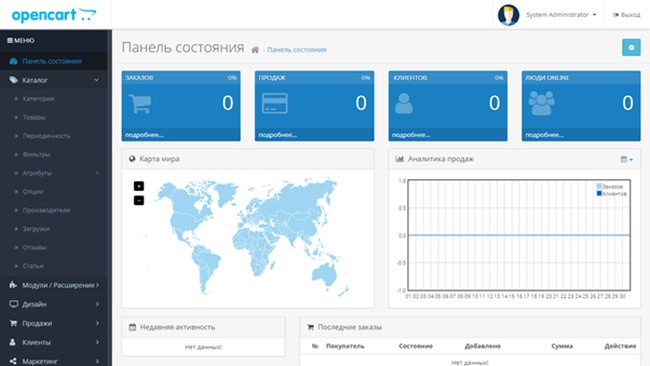
The panel consists of nine main sections:
- Status panel. The main page, where key information about the store is collected – sales statistics, information on turnover, visitor activity, etc.
- Catalog. This is a section for managing the assortment and content of the website. Here product items are added and edited, filters and product categories are created, descriptions and characteristics are configured.
- Modules. This section is required to add additional plugins. It expands the capabilities of the market through third-party solutions – connecting payment services, delivery services, SEO add-ons, etc.
- Design. Here you can edit the visual component, change the location and appearance of blocks, adjust the layout and customize the page design in accordance with the company’s corporate style.
- Sales. Information about orders, their status, information about purchases and refusals is displayed here. The seller can track the dynamics of product sales and analyze customer behavior.
- Marketing. This section makes it possible to connect coupons, discounts, mailings and other promotions to attract customers. This helps increase turnover and audience loyalty through smart marketing campaigns.
- Clients. Here control is organized over the client base, their personal and contact information. Here you can segment the database, analyze its history, or set up, for example, automatic birthday greetings.
- System. This contains general settings of the online platform – localization, taxes, payment and delivery, SEO and security.
- Reports. It contains detailed statistics and analytics that help track the dynamics, effectiveness of advertising and the behavior of potential customers.
Extensions and modules
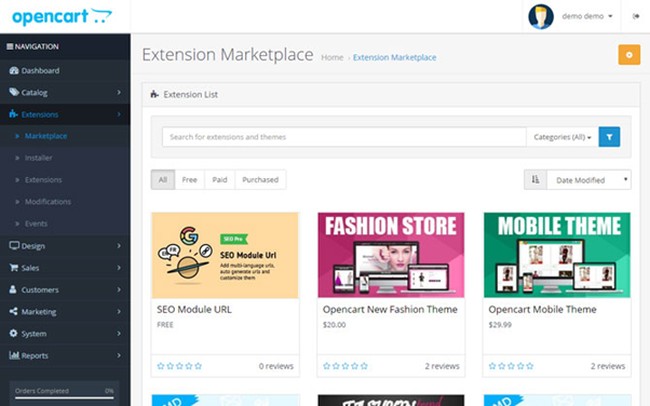
The potential of the online store can be expanded with add-ons from third-party developers. Already in the basic package there are useful built-in solutions – “Hits” and “New” blocks for highlighting popular positions, sliders and carousels for visual presentation of products, protection from robots and fraudsters via IP and integration with Google Shopping.
The basic assembly also contains a ready-made mechanism for creating a site map, built-in reports and analytics, as well as a variety of delivery and pricing options, tools for applying discounts, bonuses and taxes.
How many calls and sales will I get by ordering contextual advertising from you?
I need to calculate the conversion of my website Describe
the task
in the application
Calculate potential ad revenue Google
contextual advertising calculator
Certain add-ons are not initially activated, while others are launched by default. The administrator can independently connect the set of functions he needs.
Other solutions can be integrated in several ways – install from the official marketplace, manually upload a downloaded add-on, or copy files to hosting via FTP. After this, the module must be activated and configured.
Accepting online payments
OpenCart functionality allows you to integrate services for accepting payments in an online store. The basic version of the system supports the connection of popular Ukrainian services – LiqPay, Wayforpay and Fondy, which provides convenient payment for local buyers through their usual channels.
In addition, there is integration of international payment gateways – 2CheckOut, Authorize and iPayment. They are necessary to accept payments from foreign customers using Visa, MasterCard and other common methods. You can also set up to accept payments via PayPal. This is a convenient payment method for those who already have an account in this system.
Integration with external services
Thanks to the open source code in PHP, OpenCart integrates perfectly with other services. A qualified developer is able to implement two-way data exchange between the store and third-party resources – upload the catalog to marketplaces, transfer customer information to CRM systems, as well as import and export any necessary information.
For synchronization, you can use ready-made offers from developers who can quickly and at an affordable price implement the necessary connections. As an alternative, you can use RPA automation technologies or order individual development of a module for the specific needs of the project.
This approach significantly expands the potential through integrations and collects all the necessary business intelligence in one place, using the content management system as a central platform for e-commerce.
Analytics and statistics
The engine is equipped with built-in reporting and analytics that tracks performance and analyzes business indicators. The administrator has the right to set up detailed reports on orders, returns, best-selling products and other important metrics, so that assortment, marketing and other processes can be optimized.
A wide range of settings is also provided for the effective presentation of goods, linking discounts and promotions, creating an affiliate program and delivery conditions. Combined with our own statistics, this forms a powerful toolkit for business analysis and optimization. The administrator receives a single dashboard for monitoring and improving performance.
Export and import of data
Automation of loading product items using special add-ons significantly speeds up and simplifies the filling of the catalog, which is especially important when there is a large volume of assortment.
Among popular offers:
- “CSV Import Pro”. This is a paid addition to import from Excel tables with understandable configurations, support for multi-store and automatic recount of prices.
- “Import/Export XLS”. Easy to use the import of tabular data, which completely updates the catalog, but has restrictions on the size of uploaded files and does not maintain old positions.
- “Import XLS and CSV”. A paid solution with the settings of fields and categories that tunes in detail a comparison of the XLS/CSV columns with fields in goods cards.
- “Work with the price lists.” It is used to load positions from different price lists, generation of the margin, auto-renewal of availability in warehouse and price adjustment. This is very convenient if it is necessary to track regular updates from suppliers.
- “Automatic price processing.” This is a multifunctional expansion with configurations for each supplier, which loads and combines prices from several price lists.
Opportunities for promoting the site on CMS Opencart
Using the widely capabilities of the Opencart, you can apply actual promotion methods – from the basic optimization for the search engines to the maintenance of your blog.
SEO optimization

Optimization of content, meta tags, turning and other parameters contribute to the growth of the page visibility in the search results. The engine is originally adapted to the requirements of search engines – it generates understandable URLs and makes it possible to create unique headlines and descriptions of pages, add keywords, configure redirects.
Design templates are usually cross -browser and adaptive, which positively affects usability. There are built -in options for closing from indexing individual sections and connecting Google Analytics.
A set of functions can be additionally expanded by SEO modules. They allow you to generate a site card, optimize navigation, pages 404, automatically generate meta tags and much more.
Blog connection
“out of the box” the blog is limited by the creation of ordinary information pages without categorization and taging. But thanks to additional solutions, the functionality can be significantly expanded by receiving a full-fledged blog with all modern chips.
After that, you will have a separate type of categories for articles. The publications themselves will be available for configuration brief descriptions, tags, active transplanting. Information about the authors of the records will also be added. By filling the blog with high -quality optimized content on relevant topics, you can not only form additional traffic, but also increase the trust of the brand and collect the audience of subscribers.
Reviews of fresh models, advice on their use or analytics of trends in your field – demanded content increases the value of the offer in the eyes of customers. In addition, having connected goods with specific articles of the blog through tags or direct links, you can get additional sales.
The cost of using the Opencart engine
Although the platform itself is free, the launch of the online store requires certain financial investments. Firstly, you need hosting that provides uninterrupted functioning of the page, as well as protection of user data. The cost of tariff plans starts from about $4 per month.
In addition, you will have to pay for visual design and the necessary additional functionality for the OpenCart engine. The price of popular paid templates starts at $20, and plugins can cost from $10 to $100.
At the same time, the development of a large-scale project will require the services of developers, SEO specialists, copywriters and marketers, which will entail additional injections of funds.
In such a way as to launch a full-fledged online store with a unique design and basic modules, the initial investment will make up at least a few hundred dollars.


